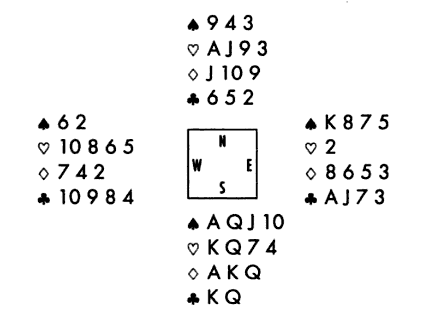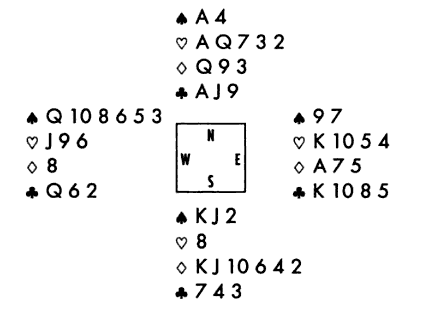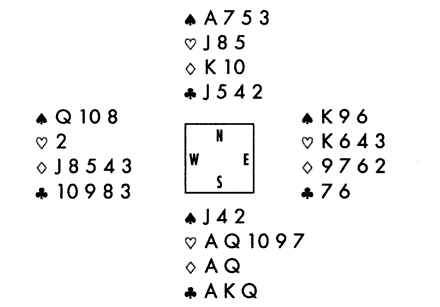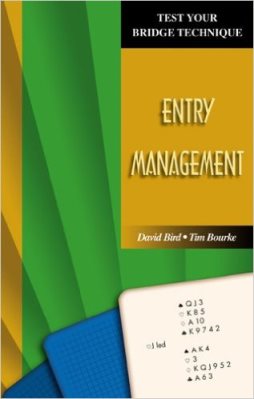Source: Entry Management By David Bird, Tim Bourke
Entry management ensures that you are in the right hand at the right time and is an important part of planning the play of a hand. It may involve special techniques within a single suit — to create extra entries or to avoid blockages that would kill a necessary entry. One such technique is needed on this deal:

You arrive in 6 and West leads the
and West leads the  10 to his partner’s ace. Back comes a club and you win in your hand. The next move is obvious. Yes, you stop to make a plan! To avoid losing a spade trick, you will need to find East with the
10 to his partner’s ace. Back comes a club and you win in your hand. The next move is obvious. Yes, you stop to make a plan! To avoid losing a spade trick, you will need to find East with the  K. That’s not the end of the story, though. If East holds four or more spades, you will need three entries to dummy so that you can take three spade finesses.
K. That’s not the end of the story, though. If East holds four or more spades, you will need three entries to dummy so that you can take three spade finesses.
After winning the second round of clubs, you should draw one round of trumps with the king. When you lead the  Q at Trick 4, West follows suit. It is then safe to overtake with dummy’s
Q at Trick 4, West follows suit. It is then safe to overtake with dummy’s  A. By overtaking the queen with the ace, you promote the value of dummy’s jack and nine of hearts. In fact you promote them into the second and third entries that you need to the dummy.
A. By overtaking the queen with the ace, you promote the value of dummy’s jack and nine of hearts. In fact you promote them into the second and third entries that you need to the dummy.
East shows out on the second round of trumps but this causes no problem. You finesse the  Q and justice is done (your opponents may not agree) when the finesse wins. You return to dummy by taking a marked finesse of the
Q and justice is done (your opponents may not agree) when the finesse wins. You return to dummy by taking a marked finesse of the  9 and repeat the spade finesse. Finally you cross to dummy’s
9 and repeat the spade finesse. Finally you cross to dummy’s  J and finesse yet again in spades. East did indeed hold
J and finesse yet again in spades. East did indeed hold  K-x-x-x, so your elegant maneuver in the trump suit proved to be necessary.
K-x-x-x, so your elegant maneuver in the trump suit proved to be necessary.
Sometimes entry management is just a fancy name for making plays in the right order. When you need to set up a side suit in dummy, it may be necessary to use the entries that dummy’s trump holding provides.

West leads the  Q against your contract of 4
Q against your contract of 4 . (3NT would have been more sensible, yes, but you like a challenge.) You win with the
. (3NT would have been more sensible, yes, but you like a challenge.) You win with the  A and see that you have two heart losers and two club losers staring you in the face. How should you play the contract? The only chance to dispose of a loser is to establish dummy’s diamond suit. Since you will have to take three diamond ruffs and then return to dummy to enjoy the long card, you will need four entries to the dummy. The red aces will give you two entries. The other two entries will have to come from the trump suit and this will mean taking an ‘unnecessary finesse’. After winning the club lead, you cross to the
A and see that you have two heart losers and two club losers staring you in the face. How should you play the contract? The only chance to dispose of a loser is to establish dummy’s diamond suit. Since you will have to take three diamond ruffs and then return to dummy to enjoy the long card, you will need four entries to the dummy. The red aces will give you two entries. The other two entries will have to come from the trump suit and this will mean taking an ‘unnecessary finesse’. After winning the club lead, you cross to the  A and ruff a diamond. You then, very casually, play a spade to the nine. Yes the
A and ruff a diamond. You then, very casually, play a spade to the nine. Yes the
finesse wins!
A second diamond ruff is followed by a trump to the king and a third diamond ruff with a high trump. Now all that remains is to draw West’s last trump and to cross to the  A. You can then discard one of your losers on the established card in diamonds. If West had made an inspired opening lead in one of the majors, this would have killed the contract. Sometimes the only entry management that is needed is to win the opening lead in the right hand. An inexperienced player might go wrong on this deal:
A. You can then discard one of your losers on the established card in diamonds. If West had made an inspired opening lead in one of the majors, this would have killed the contract. Sometimes the only entry management that is needed is to win the opening lead in the right hand. An inexperienced player might go wrong on this deal:

West leads the  6 against 3NT. You win in your hand with the
6 against 3NT. You win in your hand with the  J and pause to make a plan. Do you? It’s too late! When you play on the diamond suit East will hold up his ace until the third round. With no entry to the South hand you will score only two diamond tricks. There will be no way to recover. The right time to make a plan is before your first play from dummy. Here you have four top cards outside the diamond suit. By adding five diamond winners to this total, you will make the game easily. To guarantee an entry to the established diamond winners, you should win the opening lead with dummy’s
J and pause to make a plan. Do you? It’s too late! When you play on the diamond suit East will hold up his ace until the third round. With no entry to the South hand you will score only two diamond tricks. There will be no way to recover. The right time to make a plan is before your first play from dummy. Here you have four top cards outside the diamond suit. By adding five diamond winners to this total, you will make the game easily. To guarantee an entry to the established diamond winners, you should win the opening lead with dummy’s  A. It will then make no difference if East holds up the diamond ace for two rounds. When you regain the lead, you will be able to cross to the South hand with the
A. It will then make no difference if East holds up the diamond ace for two rounds. When you regain the lead, you will be able to cross to the South hand with the  K. Let’s look next at some plays that aim to avoid a blockage in a suit.
K. Let’s look next at some plays that aim to avoid a blockage in a suit.
Would you have seen the danger on the next deal?
 Overbidding somewhat, you arrive in 6
Overbidding somewhat, you arrive in 6 . How will you play this contract when West leads the
. How will you play this contract when West leads the  10? You have two potential losers in spades and one in the trump suit. You must aim to throw one spade loser on dummy’s fourth club and to pick up the trump suit without loss by finessing against East’s king. (You hope it will be East’s king, anyway.) You win the club lead in your hand and cross to dummy by over-taking the
10? You have two potential losers in spades and one in the trump suit. You must aim to throw one spade loser on dummy’s fourth club and to pick up the trump suit without loss by finessing against East’s king. (You hope it will be East’s king, anyway.) You win the club lead in your hand and cross to dummy by over-taking the  Q with the
Q with the  K. Suppose your next move is to lead the
K. Suppose your next move is to lead the  J, playing the
J, playing the  7 from your hand when East does not cover. You will go down. The finesse will win but when you repeat the finesse you will have to win in the South hand. There is only one entry to the dummy left (the
7 from your hand when East does not cover. You will go down. The finesse will win but when you repeat the finesse you will have to win in the South hand. There is only one entry to the dummy left (the  A) and you cannot afford to use that for a third trump finesse. That’s because the final entry will be needed to score the
A) and you cannot afford to use that for a third trump finesse. That’s because the final entry will be needed to score the  J after that suit has been unblocked. So, when you lead the
J after that suit has been unblocked. So, when you lead the  J at Trick 3 you should follow with the
J at Trick 3 you should follow with the  10 or
10 or  9 from your hand. You can then lead the
9 from your hand. You can then lead the  8, playing the
8, playing the  7 from your hand. The lead will still be in dummy. You take a third finesse in hearts and draw East’s last trump. It will then be a simple matter to cash the remaining two club winners in your hand and to enter dummy with the
7 from your hand. The lead will still be in dummy. You take a third finesse in hearts and draw East’s last trump. It will then be a simple matter to cash the remaining two club winners in your hand and to enter dummy with the  A to cash the
A to cash the  J. Away will go one of your spade losers and the slam is yours. As a final example of managing your entries carefully we will look at the common technique of winning a trick with a higher card than is necessary. Your aim is to promote a lesser card in the dummy into an entry.
J. Away will go one of your spade losers and the slam is yours. As a final example of managing your entries carefully we will look at the common technique of winning a trick with a higher card than is necessary. Your aim is to promote a lesser card in the dummy into an entry.
 West leads the
West leads the  2 against your small slam in hearts. Perhaps you think that no harm can be done by playing the
2 against your small slam in hearts. Perhaps you think that no harm can be done by playing the  10 from dummy. Do that and you will go down! East knows that the opening lead is either a singleton or (less likely) from
10 from dummy. Do that and you will go down! East knows that the opening lead is either a singleton or (less likely) from  J-5-2. In neither case can there be any benefit in playing his king. He will play low and — twist and turn as you may — you will then go down, losing one spade and one diamond (or a ruff and a diamond if you attempt a spade finesse at Trick 2). To make the slam you must not only play low from dummy on the first trick, you must also win the ace. No further magic is required. You will draw trumps, play the
J-5-2. In neither case can there be any benefit in playing his king. He will play low and — twist and turn as you may — you will then go down, losing one spade and one diamond (or a ruff and a diamond if you attempt a spade finesse at Trick 2). To make the slam you must not only play low from dummy on the first trick, you must also win the ace. No further magic is required. You will draw trumps, play the  A and lead the
A and lead the  5 to dummy’s
5 to dummy’s  10. Whether or not East takes his
10. Whether or not East takes his  K on this round, you will gain access to the dummy and take a diamond discard on the
K on this round, you will gain access to the dummy and take a diamond discard on the  K. Exactly the same play is required, of course, if West has led a spade from K-x-x-x. Unless you win the first trick with the ace, West can prevent you from gaining access to the dummy.
K. Exactly the same play is required, of course, if West has led a spade from K-x-x-x. Unless you win the first trick with the ace, West can prevent you from gaining access to the dummy.
